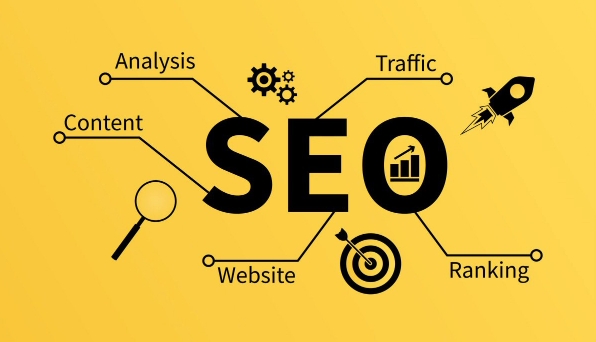How to do SEO for an e-commerce website
SEO for e-commerce websites involves attracting the right visitors through technical setup, content strategy, and optimization. First, optimize product pages by conducting keyword research, using keywords naturally in titles, descriptions, URLs, and subheadings, writing unique benefit-driven descriptions, and including keyword variations. Second, improve site speed and technical SEO by compressing images, leveraging browser caching, fixing broken links, and ensuring mobile-friendliness. Third, build high-quality backlinks by creating useful content like guides and infographics, partnering with influencers, listing on comparison sites, and getting featured in roundups. Fourth, take advantage of structured data and rich snippets by adding schema markup in JSON-LD format, encouraging customer reviews, and using plugins to simplify implementation. These steps enhance visibility, user experience, and conversions.

SEO for an e-commerce website isn’t just about getting more traffic—it’s about attracting the right kind of visitors who are likely to buy. The key is combining technical setup, content strategy, and smart optimization to make your products easy to find and appealing to both search engines and shoppers.

Optimize Product Pages for Keywords
Most people start their shopping journey with a search query. That means each product page should be built around specific keywords that match what users are typing into Google.

- Do keyword research: Use tools like Ahrefs, SEMrush, or even Google’s Keyword Planner to find relevant terms with decent search volume and manageable competition.
- Use keywords naturally: Place your main keyword in the product title, description, URL, and at least one subheading. Don’t force it—readability matters.
- Write unique descriptions: Avoid copying manufacturer text. Write original, benefit-driven content that answers questions a buyer might have.
- Include variations: If you sell “wireless Bluetooth headphones,” also mention related phrases like “noise-canceling wireless earbuds” or “Bluetooth earphones for running.”
A well-optimized product page doesn’t just rank better—it converts better too.
Improve Site Speed and Technical SEO
E-commerce sites often suffer from bloated pages, slow load times, and messy site structures. Fixing these issues can have a big impact on rankings and user experience.

Here’s what to focus on:
- Compress images: Large image files are one of the biggest slowdown culprits. Use tools like TinyPNG or Squoosh to compress without losing quality.
- Leverage browser caching: This allows returning visitors to load pages faster by storing parts of your site locally.
- Fix broken links: Regularly scan your site using tools like Screaming Frog or Google Search Console to catch 404 errors.
- Make sure your site is mobile-friendly: More than half of all online shopping happens on mobile devices. Test your site with Google’s Mobile-Friendly Test tool.
Google rewards fast, clean websites. If your site feels sluggish or disorganized, it’s time to clean up the backend.
Build High-Quality Backlinks
Backlinks are still a major ranking factor. For e-commerce sites, earning natural links can be tricky—but not impossible.
Try these tactics:
- Create useful content: Think beyond product pages. How-to guides, buying guides, and niche infographics can attract links from bloggers and influencers.
- Partner with influencers or bloggers: Offer free samples or affiliate deals in exchange for honest reviews or mentions.
- List your products on comparison sites: Platforms like PriceGrabber or Shopzilla can drive referral traffic and sometimes backlinks.
- Get featured in roundups: Reach out to bloggers who publish “best of” lists in your niche and pitch your products.
It takes time, but consistent outreach and valuable content will help build a strong backlink profile.
Take Advantage of Structured Data and Rich Snippets
When your product shows up in search results with star ratings, price, and availability, it stands out—and gets more clicks. That’s the power of structured data.
What you can do:
- Add schema markup to your product pages to tell search engines exactly what’s on the page—like price, availability, and reviews.
- Encourage customer reviews—they feed into rich snippets and boost credibility.
- Use JSON-LD format, which is recommended by Google and easier to implement than other formats.
Many e-commerce platforms (like Shopify or WooCommerce) have plugins that simplify this process, so don’t feel like you need to code everything yourself.
That’s basically how you start doing effective SEO for an e-commerce site. It’s not magic—it’s attention to detail, consistency, and focusing on what helps real users. Some parts take more effort than others, but skipping them usually shows in your traffic and sales.
The above is the detailed content of How to do SEO for an e-commerce website. For more information, please follow other related articles on the PHP Chinese website!

Hot AI Tools

Undress AI Tool
Undress images for free

Undresser.AI Undress
AI-powered app for creating realistic nude photos

AI Clothes Remover
Online AI tool for removing clothes from photos.

Clothoff.io
AI clothes remover

Video Face Swap
Swap faces in any video effortlessly with our completely free AI face swap tool!

Hot Article

Hot Tools

Notepad++7.3.1
Easy-to-use and free code editor

SublimeText3 Chinese version
Chinese version, very easy to use

Zend Studio 13.0.1
Powerful PHP integrated development environment

Dreamweaver CS6
Visual web development tools

SublimeText3 Mac version
God-level code editing software (SublimeText3)
 Reddit shown excessively in Google product review search results, study finds
Jul 15, 2025 am 09:13 AM
Reddit shown excessively in Google product review search results, study finds
Jul 15, 2025 am 09:13 AM
Reddit appears in 97.5% of Google Search queries related to product reviews and holds almost two-thirds of the spots within Google’s Discussions and forums feature on search results pages, according to a new analysis.Why it matters. While Reddit can
 SEO for user activation, retention and community
Jul 13, 2025 am 09:19 AM
SEO for user activation, retention and community
Jul 13, 2025 am 09:19 AM
SEO has traditionally been viewed as an acquisition channel, focusing on ranking websites to generate more traffic and leads. However, the role of SEO can extend far beyond just acquisition.This article explores how SEO can strategically influence us
 Google adds support for product variants and clarifies return fees
Jul 14, 2025 am 09:16 AM
Google adds support for product variants and clarifies return fees
Jul 14, 2025 am 09:16 AM
Google has introduced new structured data features to better support product variants for online retailers. This update includes detailed technical guidance on implementing the new structured data, as well as enhancements to Search Console and rich r
 Experience a key factor during Google algorithm updates, analysis finds
Jul 13, 2025 am 09:21 AM
Experience a key factor during Google algorithm updates, analysis finds
Jul 13, 2025 am 09:21 AM
According to a recent correlation study by Zyppy SEO, websites that utilized first-person pronouns, showcased personal experience, and displayed a cookie consent banner were more likely to experience positive visibility improvements during Google upd
 How to do SEO for a blog?
Jul 10, 2025 am 11:20 AM
How to do SEO for a blog?
Jul 10, 2025 am 11:20 AM
If you want to get more exposure to your blog, doing a good job of SEO is the key. 1. Choosing the right keywords is the basis. Using tools to find long-tail words with high search volume and moderate competition can effectively improve traffic potential. 2. The content structure should be clear and title tags such as H1 and H2 should be used reasonably to help search engines quickly understand content logic and improve readers' reading experience. 3. Page experience is equally important, including loading speed, mobile adaptation, image optimization, concise themes and natural link layout. These factors directly affect whether the content can be recommended for a long time. By insisting on implementing these key points in each article, you can gradually improve the search ranking and visibility of your blog.
 Forget PageRank: Here's why you should focus on ranking instead
Jul 13, 2025 am 09:20 AM
Forget PageRank: Here's why you should focus on ranking instead
Jul 13, 2025 am 09:20 AM
Despite new trends and innovative tools like AI stealing the limelight occasionally, many competitive industries continue to focus their SEO efforts primarily on building PageRank-passing link building. The basic assumption is that accumulating m
 This day in search marketing history: February 29
Jul 12, 2025 am 09:36 AM
This day in search marketing history: February 29
Jul 12, 2025 am 09:36 AM
Spreading Santorum drops on GoogleIn 2012, the webpage "Spreading Santorum," which described “santorum” as a residue of anal sex, was finally removed from the top search results on Google.However, the original anti-Santorum website persiste
 Google wants you to label AI-generated images used in Merchant Center
Jul 14, 2025 am 09:14 AM
Google wants you to label AI-generated images used in Merchant Center
Jul 14, 2025 am 09:14 AM
Google Merchant Center has confirmed that if you incorporate AI-generated images in your Merchant Center feed, you are required to disclose that the image was produced using generative AI.In a statement, Google said, “If you’re using AI-generated ima







